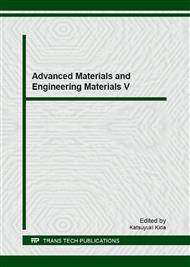[1]
D. Ignacio, F. Diana, F. G. Jorge, A. W. Erika, A kinetic study of textile dyeing wastewater degradation by penicillium chrysogenum, Bioproc. Biosyst. Eng. 38 (2015) 1019-1031.
DOI: 10.1007/s00449-014-1344-9
Google Scholar
[2]
R. Khan, P. Bhawana, M. H. Fulekar, Microbial decolorization and degradation of synthetic dyes: a review, Rev. Environ. Sci. Biotechnol. 12 (2013) 75-97.
DOI: 10.1007/s11157-012-9287-6
Google Scholar
[3]
C. C. Hsueh, B. Y. Chen, Exploring effects of chemical structure on azo dye decolorization characteristics by Pseudomonas luteola, J. Hazard Mater. 154 (2008) 703-710.
DOI: 10.1016/j.jhazmat.2007.10.083
Google Scholar
[4]
J. Peng, S. Lee, Atmospheric pressure plasma degradation of azo dyes in water: ph and structural effects, Plasma Chem. Plasma P. 33 (2013) 1063-1072.
DOI: 10.1007/s11090-013-9483-3
Google Scholar
[5]
C. O'Neill, A. Lopez, S. Esteves, F. R. Hawkes, D. L. Hawkes, S. Wilcox, Azo-dye degradation in an anaerobic-aerobic treatment system operating on simulated textile effluent, Appl. Microbiol. Biotechnol. 53 (2000) 249-254.
DOI: 10.1007/s002530050016
Google Scholar
[6]
R.V. Solomon, I. S. Lydia, J. P. Merlin, P. Venuvanalingam, Enhanced photocatalytic degradation of azo dyes using nano Fe3O4, J. Iran. Chem. Soc. 9 (2012) 101-109.
DOI: 10.1007/s13738-011-0033-8
Google Scholar
[7]
F. Scaglione, L. Battezzati, Metastable microstructures containing zero valent iron for fast degradation of azo dyes, J. Mater. Sci. 50 (2015) 5238-5243.
DOI: 10.1007/s10853-015-9071-4
Google Scholar
[8]
I. K. Konstantinou, T. A. Albanis, TiO2-assisted photocatalytic degradation of azo dyes in aqueous solution: kinetic and mechanistic investigations: a review, Appl. Catal. B Environ. 49 (2004) 1-14.
DOI: 10.1016/j.apcatb.2003.11.010
Google Scholar
[9]
A. Saffar-Teluri, S. Bolouk, M. H. Amini, Synthesis of ZnO microcrystals and their photocatalytic ability in the degradation of textile azo dyes, Res. Chem. Intermed. 39 (2013) 3345-3353.
DOI: 10.1007/s11164-012-0847-8
Google Scholar
[10]
W. X. Chen, W. Y. Lu, Y. Y. Yao, M. H. Xu, Highly efficient decomposition of organic dyes by aqueous-fiber phase transfer and in situ catalytic oxidation using fiber supported cobalt phthalocyanine, Environ. Sci. Technol. 41 (2007) 6240-6245.
DOI: 10.1021/es070002k
Google Scholar
[11]
M. Xu, Y. Cao, X. Ma, Kinetic Research on catalytic degradation of rhodamine B with cobalt phthalocyanine supported Mg-Al hydrotalcite, J. Nanosci. Nanotechno. 15 (2015) 1-4.
DOI: 10.1166/jnn.2016.10816
Google Scholar
[12]
M. Hou, F. Li, X. Liu, X. Wang, H. Wan, The effect of substituent groups on the reductive degradation of azo dyes by zerovalent iron, J. Hazard. Mater. 145 (2007) 305-314.
DOI: 10.1016/j.jhazmat.2006.11.019
Google Scholar


